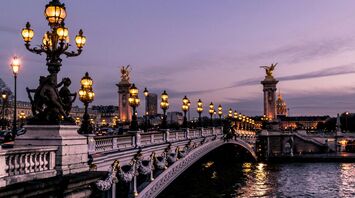Relive the Roaring ’20s in Paris: 6 Must-Do Experiences

From peeking into artist ateliers to sipping coffee at La Coupole, here’s how to still find the magic of Paris from when it last hosted the Olympics 100 years ago.
A century ago, when Paris last hosted the Olympics, the city was a giant party, seducing visitors from all over the world. More than 600,000 spectators crowded the stands, including Americans who disembarked transatlantic liners at Le Havre. Between sports events, they took in the sights that made Paris one of Europe’s most touristed destinations at the time—including the Eiffel Tower, which showed off a new paint job for its 35th birthday. Above all, visitors soaked up the city’s exuberant ambiance.
The Roaring Twenties was a time of rule-breaking and artistic creativity. After the unspeakable horrors of World War I, the mood in the French capital embraced freedom and fun. It was a cosmopolitan scene: Kiki de Montparnasse danced on bar tops, Ernest Hemingway scribbled in cafés, Pablo Picasso prodigiously painted. "Paris was perceived as the capital of the world at the time," said historian Pascal Blanchard, one of the curators of "Olympism: A History of the World" at the Palais de la Porte Dorée (Immigration History Museum).
The 1924 Olympics played out amid this urban fervor. Here’s how you can experience some of that Parisian spirit today.
1. Dive into Olympic History at Georges Vallery Pool
This summer’s Games will take place amid the challenges of climate change. Paris 2024 organizers aim to cut the carbon footprint in half by prioritizing renewable energy, catering eco-friendly food, and restricting the building of new sports venues. An example of this sustainability strategy is the 50-meter pool where Johnny Weissmuller made history at the 1924 Games when he swam 100 meters in less than a minute. Newly renamed for Georges Vallery, a swimming champion and World War II hero, the century-old aquatic center with a retractable roof got a complete makeover using reclaimed materials. Now locals and visitors alike can dive into the pool that was the first in the world to be purpose-built for Olympic events.
2. Explore the Artistic Legacy of Montparnasse
Nowhere better encapsulated the spirit of Les Années Folles than Montparnasse. École de Paris artists—think Marc Chagall, Amedeo Modigliani, and Kees Van Dongen—converged here to experiment with what’s now called "modern art." Many artists’ studios are privately owned now, but you can discern their former function by their large glass windows. Other ateliers have been turned into museums, such as those of sculptors Ossip Zadkine and Chana Orloff.
3. Experience the Charm of Historic Cafés
Cafés were central to the Montparnasse scene. Particularly notorious were the four brasseries facing each other at the Carrefour Vavin: Le Select, Le Dôme, La Coupole, and La Rotonde. Today, tables still crowd the sidewalk terraces in front of this quartet. White-aproned waiters bustle across the mosaic floors at La Coupole, while Le Dôme serves seafood platters with Art Deco vibes. La Rotonde’s red velvet banquettes hosted President Emmanuel Macron’s first victory party.
4. Enjoy Classic Cocktails and Absinthe
Dingo’s Bar—where Hemingway first met F. Scott Fitzgerald—has been preserved inside an Italian restaurant called the Auberge de Venise. And next to Port Royal, La Closerie des Lilas—where Fitzgerald asked Hemingway to read The Great Gatsby—is one of the rare places in Paris you can drink a real absinthe. Across town at the Place Vendôme, the Ritz Paris opened its first bar in 1921. Today, the no-reservations Bar Hemingway draws cocktail enthusiasts keen to sip a sidecar surrounded by vintage memorabilia.
5. Watch a Film in a Historic Cinema
Beyond the wild parties, Paris was a cultural trailblazer in the 1920s. Le Louxor opened in 1921 as one of the capital’s first cinemas. Decked out in hieroglyphs, the 1,140-seat venue drew its stylistic inspiration from both art deco and ancient Egypt. Nowadays the "cinema palace"—which had a stint as a nightclub in the 1980s—screens a wide variety of films.
6. Experience the Spectacle of Parisian Entertainment
The Bal Blomet, opened in 1924 as a cabaret, drew the beau monde for beguine music from Martinique. Today, the restored venue is billed as the oldest jazz club in Europe still in operation. The Folies Bergère, Paris’s first music hall, continues to stage original productions. Designated a historic monument, the theater showcases innovative programming, echoing the creative spirit of the Roaring Twenties.
Paris, with its blend of history, culture, and vibrant social life, offers a unique and unforgettable experience reminiscent of the exuberant 1920s.



















